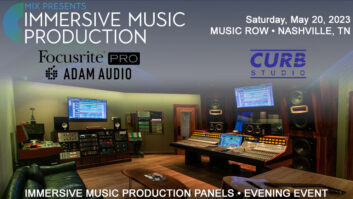I’ve been ambivalent about software subscriptions ever since the first plans started appearing. On the one hand, they provide access to a lot more software for your dollar than you’d get by purchasing permanent licenses for individual titles.
A couple of examples of high-value subscription plans are the Slate Digital and McDSP subscription plans, both of which give you access to an entire catalog of plug-ins for about $15 a month. That’s a lot of bang for your buck.
However, subscribing to software is kind of like leasing a car. You can get lower monthly payments, but your payments don’t go toward owning the product. Worse, if you stop paying for it, you lose access.
Read more Mix Blog Studio: Take My Files, Please!
For those of us producing music that’s a potentially problematic issue, because if you have recording projects that you might need to reopen in the future, and you used subscription plug-ins on the mixes, you won’t be able to re-create them accurately if your subscription to your DAW or plug-ins has lapsed. And while it’s true that you could re-subscribe, what if the software developer discontinued the plug-in (or plug-ins) you used on the mix? Or worst-case-scenario, what if they go out of business?
The “Rent to Own” program from Splice is a new music-software distribution model that bridges the gap between owning and renting. It allows you to make small monthly payments for software titles—similar to what you’d pay in a subscription program, but after about 24 monthly payments, you own the software.
You don’t get as much immediate value, because these programs typically cover a single plug-in or software title, but your payments are going towards ownership, which eliminates most of the potential access issues mentioned earlier.
Splice’s Rent-to-Own program recently added a DAW to its offerings, PreSonus Studio One 4 Professional, in addition to its growing assortment of plug-ins.
I recently talked to Andrew Hapke from Splice about this new business model. “All Rent-to-Own plans start with a free trial, and musicians can pause their plans at any time and pick up where they left off,” he says. “With Rent-to-Own, musicians can try new gear without high up-front investments, see what fits, and stop paying for it if they’re not using it.”
I did the math on several of Splice’s offerings, and for some you end up paying a bit more with Rent-to-Own—compared to street prices—than you would if you just bought it, but for others, it comes out to about the same.
“Rent-to-Own gives musicians a path to ownership of their gear,” Hapke says, “unlike traditional subscription models that require endless payments for access.”
I think that’s a key point. Being a musician, engineer or producer doesn’t typically offer stable and predictable income, and there might be points in your career where you just can’t afford software subscription payments.
Not only does Rent-to-Own lead to ownership of the software, but you can stop and restart the payments without losing out on what you’ve already paid. For younger musicians, mainly, who are going “all-in” on their careers, Splice’s program offers a lot of advantages.
When speculating about whether Rent-to-Own might become a model that’s adopted by other companies, it’s important to remember that Splice isn’t a developer, they’re distributing software created by other companies.
Will developers be tempted to institute this type of program themselves? It’s hard to say, but it would undoubtedly be an advantageous development for the customer side of the music-software market.







